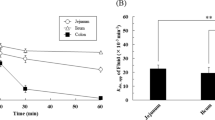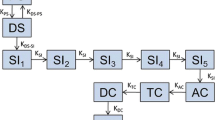Abstract
Purpose
To measure fasted and fed gastric pH and gastric residence time (GRT) in Cynomolgus monkeys using Bravo® radiotelemetry capsules.
Methods
Continuous pH measurements were recorded with Bravo® capsules, which were either attached to the monkeys’ stomach or administered as free capsules. Meals (either slurry or standard), were administered at designated times with monkeys chair-restrained during slurry meal ingestion.
Results
From the attached capsule studies, the fasted gastric pH (∼1.9–2.2) was consistent among monkeys. Under fasted conditions, pH spikes were infrequently observed (once every 7.9 min to 3.6 h) with peaks reaching pH 9.4 and having short durations (<1 min). After feeding, the gastric pH rose quickly and remained alkaline for approximately 4.5–7.5 h before returning to baseline. Although significantly different (p < 0.05), there was overlap between the fasted (153 ± 87 min) and fed (436 ± 265 (slurry) and 697 ± 193 (standard) min) GRT due to considerable inter- and intra-subject variability.
Conclusions
Fasted gastric pH was similar between monkeys and literature human values. After a meal, the monkey gastric pH was elevated for a longer duration than that in human. The monkey GRT appears longer than that observed in human under both fasted and fed conditions, although this is likely dependent on the Bravo® capsule size.






Similar content being viewed by others
Abbreviations
- ANOVA:
-
analysis of variance
- FDA:
-
Food and Drug Administration
- GERD:
-
gastroesophageal reflux disease
- GRT:
-
gastric residence time
- IQR:
-
interquartile range
- MMC:
-
migrating myoelectrical complex
- Q1 :
-
25% quartile
- Q3 :
-
75% quartile
- RMSE:
-
root mean squared error
- SD:
-
standard deviation
References
L. F. Prescott. Gastrointestinal absorption of drugs. Med. Clin. North Am. 58:907–915 (1974).
P. Lelawongs, J. A. Barone, J. L. Colaizzi, A. T. Hsuan, W. Mechlinski, R. Legendre, and J. Guarnieri. Effect of food and gastric acidity on absorption of orally administered ketoconazole. Clin. Pharm. 7:228–235 (1988).
J. A. Carlson, H. J. Mann, and D. M. Canafax. Effect of pH on disintegration and dissolution of ketoconazole tablets. Am. J. Health Syst. Pharm. 40:1334–1336 (1983).
V. I. Vashi and M. C. Meyer. Effect of pH on the in vitro dissolution and in vivo absorption of controlled-released theophylline in dogs. J. Pharm. Sci. 77:760–764 (1988).
H. Ogata, N. Aoyagi, N. Kaniwa, and A. Ejima. Effect of food on bioavailability of metronidazole from sugar-coated tablets having different dissolution rates in subjects with low gastric acidity. Int. J. Clin. Pharmacol. Ther. Toxicol. 24:279–282 (1986).
N. Aoyagi, H. Ogata, N. Kaniwa, M. Koibuchi, T. Shibazaki, A. Ejima, M. Mizobe, K. Kohno, and M. Samejima. Bioavailability of sugar-coated tablets of thiamine disulfide in humans. I. Effect of gastric acidity and in vivo-in vitro correlation. Chem. Pharm. Bull. 34:281–291 (1986).
H. Ogata, N. Aoyagi, N. Kaniwa, A. Ejima, N. Sekine, M. Kitamura, and Y. Inoue. Gastric acidity dependent bioavailability of cinnarizine from two commercial capsules in healthy volunteers. Int. J. Pharm. 29:113–120 (1986).
H. Ogata, N. Aoyagi, M. Koibuchi, T. Shibazaki, and A. Ejima. Bioavailability of pyridoxal phosphate from enteric-coated tablets. II. Effects of gastric acidity of humans. Chem. Pharm. Bull. 33:3899–3905 (1985).
N. Aoyagi, H. Ogata, N. Kaniwa, and A. Ejima. Bioavailability of indomethacin capsules in humans (I) Bioavailability and effects of gastric acidity. Int. J. Clin. Pharmacol. Ther. Toxicol. 23:469–474 (1985).
H. Ogata, N. Aoyagi, N. Kaniwa, T. Shibazaki, and A. Ejima. The bioavailability of diazepam from uncoated tablets in humans—Part II: effect of gastric fluid acidity. Int. J. Clin. Pharmacol. Ther. Toxicol. 20:166–170 (1982).
Y.- H. Lee, B. A. Perry, S. Labruno, H. S. Lee, W. Stern, L. M. Falzone, and P. J. Sinko. Impact of regional intestinal pH modulation on absorption of peptide drugs: oral absorption studies of salmon calcitonin in beagle dogs. Pharm. Res. 16:1233–1239 (1999).
T. Kosoglou, D. J. Kazierad, J. J. Schentag, J. E. Patrick, L. Heimark, E. Radwanski, D. Christopher, B. E. Flannery, and M. B. Affrime. Effect of food on the oral bioavailability of isosorbide-5-mononitrate administered as an extended-release tablet. J. Clin. Pharmacol. 35:151–158 (1995).
H. Emori, K. Yamamoto, S. Yokohama, and T. Nishihata. Bioavailability of bropirimine 250 mg tablet in dogs: effect of food. J. Pharm. Pharmacol. 47:822–826 (1995).
P. Mojaverian, M. L. Rocci Jr., D. P. Conner, W. B. Abrams, and P. H. Vlasses. Effect of food on the absorption of enteric-coated aspirin: correlation with gastric residence time. Clin. Pharmacol Ther. 41:11–17 (1987).
C. Y. Lui, R. Oberle, D. Fleisher, and G. L. Amidon. Application of a radiotelemetric system to evaluate the performance of enteric-coated and plain aspirin tablets. J. Pharm. Sci. 75:469–474 (1986).
W. A. Ritschel. In vivo animal models for bioavailability assessment. S.T.P. Pharma. 3:125–141 (1987).
J. B. Dressman and K. Yamada. Animal models for oral drug absorption. In P. Welling and F. L. Tse (eds.), Pharmaceutical Bioequivalence, Dekker, New York, 1991, pp 235–266.
J. H. Lin. Species similarities and differences in pharmacokinetics (Review). Drug Metab. Dispos. 23:1008–1021 (1995).
T. T. Kararli. Comparison of the gastrointestinal anatomy, physiology and biochemistry of human and commonly used laboratory animals. Biopharm. Drug Dispos. 16:351–380 (1995).
W. L. Chiou and P. W. Buehler. Comparison of oral absorption and bioavailability of drugs between monkey and human. Pharm. Res. 19:868–874 (2002).
H. W. Smith. Observations on the flora of the alimentary tract of animals and factors affecting its composition. J. Path. Bact. 89:95–122 (1965).
C. A. Youngberg, J. Wlodyga, S. Schmaltz, J. B. Dressman. Radiotelemetric determination of gastrointestinal pH in four healthy beagles. Am. J. Vet. Res. 46:1516–1521 (1985).
J. H. Meyer, J. Dressman, A. Fink, and G. Amidon. Effect of size and density on canine gastric emptying of nondigestible solids. Gastroenterology 89:805–813 (1985).
I. Yamada and K. Haga. Measurement of gastric pH during digestion of a solid meal in dogs. Chem. Pharm. Bull. 38:1755–1756 (1990).
I. Yamada, H. Mizuta, T. Goda, K. Goda, K. Haga, and K. Ogawa. Gastric pH profile and its control in fasting beagle dogs. Chem. Pharm. Bull. 37:2539–2541 (1989).
M. Akimoto, N. Nagahata, A. Furuya, K. Fukushima, S. Higuchi, and T. Suwa. Gastric pH profiles of beagle dogs and their use as an alternative to human testing. Eur. J. Pharm. Biopharm. 49:99–102 (2000).
B. W. Watson, S. J. Meldrum, H. C. Riddle, R. L. Brown, and G. E. Sladen. pH profile of gut as measured by radiotelemetry capsule. Br. Med. J. 2:104–106 (1972).
T. Zimmermann, H. laufen, R. A. Yeates, A. Lammerich, and A. Wildfeuer. Techniques for measuring gastrointestinal pH and transit, and their application in drug development. Int. J. Pharm. Med. 13:147–154 (1999).
T. Itoh, T. Higuchi, C. R. Garnder, and L. Caldwell. Effect of particle size and food on gastric residence time of non-disintegrating solids in beagle dogs. J. Pharm. Pharmacol. 38:801–806 (1986).
T. L. Russell, R. R. Berardi, J. L. Barnett, L. C. Dermentzoglou, K. M. Jarvenpaa, S. P. Schmaltz, and J. B. Dressman. Upper gastric pH in seventy-nine healthy, elderly, North American men and women. Pharm. Res. 10:187-196 (1993).
J. B. Dressman, R. R. Berardi, L. C. Dermentzoglou, T. L. Russell, S. P. Schmaltz, J. L. Barnett, and K. M. Jarvenpaa. Upper gastric (GI) pH in young, healthy men and women. Pharm. Res. 7:756–761 (1990).
S. S. Davis, J. G. Hardy, and J. W. Fara. Transit of pharmaceutical dosage forms through the small intestine. Gut 27:886–892 (1986).
P. Mojaverian, R. K. Fergusom, P. H. Vlasses, M. L. Rocci Jr., A. Oren, J. A. Fix, L. J. Caldwell, and C. Gardner. Estimation of gastric residence time of the Heidelberg capsule in humans: effect of varying food composition. Gastroenterology 89:392–397 (1985).
P. Mojaverian, P. H. Vlasses, P. E. Kellner, and M. L. Rocci Jr. Effects of Gender, posture, and age on gastric residence time of an indigestible solid: Pharmaceutical consideratgions. Pharm. Res. 5:639–644 (1988).
P. Mojaverian, K. Chan, A. Desai, and V. John. Gastrointestinal transit of a solid indigestible capsule as measured by radiotelemetry and dual gamma scintigraphy. Pharm. Res. 6:719–724 (1989).
P. Mojaverian, J. C. Reynolds, A. Ouyang, F. Wirth, P. E. Kellner, and P. H. Vlasses. Mechanism of gastric emptying of a nondisintegrating radiotelemetry capsule in man. Pharm. Res. 8:97–100 (1991).
H. Kondo, T. Shinoda, H. Nakashima, T. Watanabe, and S. Yokohama. Characteristics of the gastric pH profiles of unfed and fed Cynomolgus monkeys as pharmaceutical product development subjects. Biopharm. Drug Dispos. 24:45–51 (2003).
K. Ikegami, K. Tagawa, S. Narisawa, and T. Osawa. Suitability of the Cynomolgus monkey as an animal model for drug absorption studies of oral dosage forms from the viewpoint of gastrointestinal physiology. Biol. Pharm. Bull. 26:1442–1447 (2003).
A. M. Merritt and J. H. Reed. Gastrointestinal function testing. In N. V. Anderson (ed.), Veterinary Gastroenterology, Lea & Febiger, Philadelphia, 1980, pp. 247–262.
C. Y. Lui, G. L. Amidon, R. R. Berardi, D. Fleisher, C. Youngberg, and J. B. Dressman. Comparison of gastrointestinal pH in dogs and humans: implications on the use of the beagle dog as a model for oral absorption in humans. J. Pharm. Sci. 75:27–274 (1986).
J. B. Dressman and G. L. Amidon. Radiotelemetric method for evaluating enteric coatings in vivo. J. Pharm. Sci. 73:935–938 (1984).
J. E. Pandolfino, J. E. Richter, T. Ours, J. M. Guardino, J. Chapman, and P. J. Kahrilas. Ambulatory esophageal pH monitoring using a wireless system. Am. J. Gastroenterol. 98:740–749 (2003).
E. M. Ward, K. R. Devault, E. P. Bouras, M. E. Starck, H. C. Wolfsen, D. M. Davis, S. I. Nedrow, and S. R. Achem. Successful oesophageal pH monitoring with a catheter-free system. Ailment Pharmacol. Ther. 19:449–454 (2004).
M. Bothwell, J. Phillips, and S. Bauer. Upper esophageal pH monitoring of children with the Bravo pH capsule. Laryngoscope 114:786–788 (2004).
J. E. Pandolfino and P. J. Kahrilas. Prolonged pH monitoring: bravo capsule. Gastrointest. Endoscopy Clin. N. Am. 15:307–318 (2005).
M. Marchese, C. Spada, F. Iacopini, P. Familiari, S. G. Shah, A. Tringali, and G. Costamagna. Endoscopy 38:813–818 (2006).
R. S. Gillies, J. M. Stratford, M. I. Booth, and T. C. B. Dehn. Oesophageal pH monitoring using the Bravo catheter-free radio capsule. Eur. J. Gastroenterol. Hepatol. 19:57–63 (2007).
B. A. Lapin and G. M. Cherkovich. Biological normals. In R. N. T.-W. Fiennes (ed.), Pathology of Simian Primates, Part I, S. Karger, Basel, 1972, pp. 78–156.
L. Bueno, J. Fioramonti, and Y. Ruckebusch. Gastric pH changes associated with duodenal motility in fasted dogs. J. Phys. 316:319–325 (1981).
E. Peters and A. Vickers. The characterization of preclinical research dogs using a combination of pH monitoring and gamma scintigraphy. Drug Deliv. Tech. 6:50–53 (2006).
J. H. Meyer, J. Dressman, A. Fink, and G. Amidon. Effect of size and density on canine gastric emptying of nondigestible solids. Gastroenterology 89:805–813 (1985).
P.-O. Stotzer, M. Fjälling, J. Grétarsdóttir, and H. Abrahamsson. Assessment of gastric emptying: comparison of solid scintigraphic emptying and emptying of radiopaque markers in patients and healthy subjects. Dig. Dis. Sci. 44:729–734 (1999).
M. Loreno, A. M. Bucceri, F. Catalano, A. Blasi, and A. Brogna. Gastric clearance of radiopaque markers in the evaluation of gastric emptying rate. Scand. J. Gastroenterol. 39:1215–1218 (2004).
V. C. Ibekwe, M. K. Khela, D. F. Evans, G. E. Parsons and A. W. Basit. Gastrointestinal pH profiles in healthy male subjects measured using a novel radiotelemetry capsule, AAPS PharmSci. 7(S2):Abstract M1156 (2005). Available from: http://www.aapspharmsci.org/.
Acknowledgments
We would like to thank Wendy Morrison, Jennifer Gilbride and summer student, Howard Wu from the Department of Drug Metabolism and Pharmacokinetics and Robert Roache, Bob Lynch, Katrina Rivera, Earl Jenkins, Debra Paul and Laura Flanagan from the department of Laboratory Animal Sciences for providing technical assistance. Also, thanks to Simon Zhuang from Biomedical Data Sciences for providing statistical support.
Author information
Authors and Affiliations
Corresponding author
Rights and permissions
About this article
Cite this article
Chen, E.P., Mahar Doan, K.M., Portelli, S. et al. Gastric pH and Gastric Residence Time in Fasted and Fed Conscious Cynomolgus Monkeys Using the Bravo® pH System. Pharm Res 25, 123–134 (2008). https://doi.org/10.1007/s11095-007-9358-5
Received:
Accepted:
Published:
Issue Date:
DOI: https://doi.org/10.1007/s11095-007-9358-5




